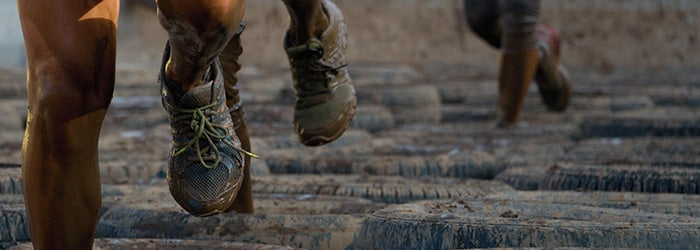The sport is known as a course with various obstacles. Running, swimming, climbing, balancing, and swinging are all part of this sport. Besides endurance and strength, you also need balance, speed, agility, coordination, and mental strength to overcome the many obstacles. In this blog, we explain how best to approach this obstacle run and what to consider during training.
The right equipment makes it easier
When doing an obstacle run, you don't need very special equipment, but the right choice in clothing can make all the difference. In particular, your clothing should be functional. Anyone who has ever been in the water with a cotton shirt knows that this is not a good choice. Therefore, wear lightweight clothing that does not absorb too much water. Gloves are not really necessary. If it gets wet or muddy, gloves will no longer serve their purpose and you are better off with bare hands. Proper footwear is the most important part of your equipment. Make sure your shoes have a good tread, are flexible, and don't easily slip off your foot and get stuck in the mud. Regular running shoes are not recommended. High-quality materials such as water-repellent fabrics are also not recommended because water can get in and stay in the shoe. The upper material should be sturdy yet water-permeable. For long distances, a drinking belt or backpack can be very useful.
A good preparation is half the battle
To be well prepared at the start, you need a good workout. All elements (endurance, strength, speed, balance, coordination and agility) must be taken into account during training. In general, endurance is the absolute basis supplemented by relevant strength training. It is also possible to combine running and strength training, as strength training can offer a nice variation on your normal running. For example, you can perform a strength exercise after every mile to simulate an obstacle. The best strength exercises are those using your own body weight. In particular, it is recommended to practice pull-ups. OCR requires you to constantly move your own body weight over obstacles. A targeted workout is a pull-up program with 6 times 10 pull-ups in different types of grip (e.g., 2x classic grip, 2x chin-ups and 2x hammer grip). If normal pull-ups are still too difficult, you can use an elastic band for support.
Technique training for the obstacles
Technique training for the OCR is highly recommended. It is best to train your technique on a real obstacle course. So look for an obstacle course in your area. After all, good technique can save you a lot of time and energy. For example, it is possible to cross a 3 m high sloping wall in less than 5 seconds. To achieve this, you need to take a strong step into the wall with speed and then use your speed to move upwards. Once you grab the top edge, pull yourself up and bring one leg over the wall. Once you reach this point, master the wall without difficulty.
But most of all, OCRs are, of course, super fun! The world of OCR is quite diverse and colorful. Whether you are a beginner or a professional, an endurance runner or strength athlete, everyone can use their individual strengths in an OCR. Together with friends, you can push your personal limits. We wish everyone who is going to participate in an OCR, lots of success but above all lots of fun!

